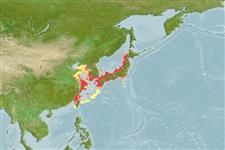Common names from other countries
Environment: milieu / climate zone / depth range / distribution range
Ecologie
marien; zoet water; brak water; amfidroom; diepte 30 - ? m (Ref. 10943). Temperate; 34°N - 17°S
Northwest Pacific: Yellow Sea, Pohai Sea, Japan Sea, and the Pacific coast of Japan, extending north to Sakhalin and to Preobrazheniye Bight and Vladivostok in the Gulf of Peter the Great. Recorded from the lower part of the Yangtze River in China. Occurrence of this species south to the Ryukyu Islands and Taiwan needs verification.
Lengte bij maturiteit / Grootte / Gewicht / Leeftijd
Maturity: Lm ?, range 17 - ? cm
Max length : 40.0 cm TL mannelijk / geslacht onbekend; (Ref. 637)
Korte beschrijving
Determinatiesleutels | Morfologie | Morfometrie
Dorsale stekels (totaal) : 0; Dorsale zachte stralen (totaal) : 14 - 18; Anale stekels: 0; Anale zachte stralen: 15 - 18; Wervels: 59 - 63. Anterior branch of its preorbital canal curved forward at an angle of about 90°. Predorsal scales 66-81; vertebrae 59-63; pectoral fin rays 12-14, usually 13. Lower jaw shorter than head length.
Common in inshore waters. Occurs in the lower part of the Yangtze River in China (Ref. 10943). Forms small schools and feed mainly on zooplankton. Meat delicious. Also caught with dip nets. Used in Chinese medicine (Ref. 12166).
Levenscyclus en paargedrag
Maturities | Voortplanting | Spawnings | Egg(s) | Fecundities | Larven
Collette, B.B. and J. Su, 1986. The halfbeaks (Pisces, Beloniformes, Hemiramphidae) of the Far East. Proc. Acad. Nat. Sci. Philadelphia 138(1):250-301. (Ref. 10943)
Status op de Rode Lijst van het IUCN (Ref. 130435)
CITES (Ref. 128078)
Not Evaluated
Gevaar voor de mens
Harmless
Gebruik door de mens
Visserij: commercieel
Tools
Speciale rapporten
Download XML
Internetbronnen
Estimates based on models
Preferred temperature (Ref.
115969): 6.9 - 21.7, mean 18.4 (based on 8 cells).
Fylogenetische diversiteitsindex (Ref.
82804): PD
50 = 0.5000 [Uniqueness, from 0.5 = low to 2.0 = high].
Bayesian length-weight: a=0.00209 (0.00116 - 0.00377), b=3.07 (2.91 - 3.23), in cm Total Length, based on LWR estimates for this species & Genus-body shape (Ref.
93245).
Trofisch niveau (Ref.
69278): 3.4 ±0.45 se; based on food items.
Weerstandsvermogen (Ref.
120179): Gemiddeld, minimale populatieverdubbelingstijd 1,4-4,4 jaar (Assuming tm=2).
Fishing Vulnerability (Ref.
59153): Low to moderate vulnerability (30 of 100).
Climate Vulnerability (Ref.
125649): Very high vulnerability (76 of 100).
